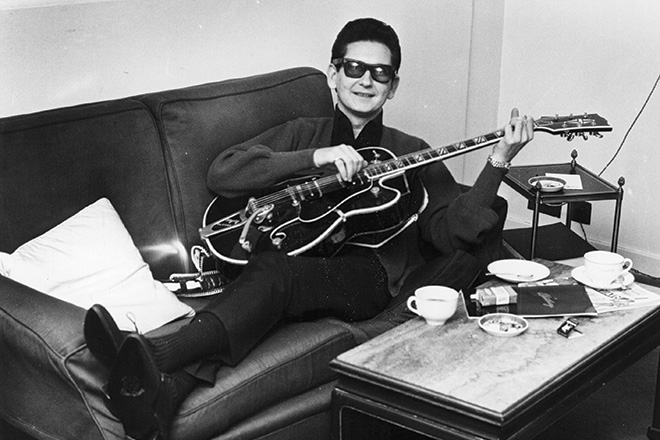“Crying”
ROY ORBISON
Roy Orbison’s ultimate aria of love and loss had its roots in a real-life episode. “I was dating this girl and we broke up,” the singer recalled. “Two or three years later, I went to the barber shop to get a haircut and looked across the street, and there was the girl I had split up with. I wanted to go over and say, ‘Let’s forget about what happened and carry on.’ But I was very stubborn. So I got in the car and drove down the street and said, ‘Boy, you really made a mistake. You didn’t play that right at all.’ I would say that I had tears in my eyes—I’ll go that far—but whether I was physically crying or just crying inside, it’s the same thing.”
As with many of his early hits, Orbison refined the tune with his friend and collaborator Joe Melson. The pair had originally intended it for another singer. “It was a song that we were working on for Don Gibson,” said Melson. “Then we decided halfway through maybe it was better for Roy.”
Producer Fred Foster recalled when Orbison brought him the finished version. “I think we changed every one of Roy’s songs a little bit—except ‘Crying.’ I thought it was a classic the first time I heard it, maybe as perfect a piece of writing as I’d ever heard.”
But it was a classic not easily captured on tape. Two initial recording sessions yielded nothing. Orbison’s publisher Wesley Rose told Foster “to give it up, that perhaps the song just didn’t have what it takes to be a single.”
For the third session, a determined Foster hired three different arrangers. He recalls, “I went to the men’s room at the studio and pulled a couple straws out of a broom that was in there and broke them into different lengths, and the three arrangers—who knew what the deal was—each drew a straw. Jim Hall drew the short straw. When the intro of his arrangement kicked off, I thought, ‘Good Lord, this may be the one.’ He had these mallets on the snare and a Stromberg guitar (renowned for its warm tone). So when we cut it, I said to the other two arrangers, ‘You’ll be paid, but there’s no sense cutting this again.’”
As for the big, operatic held note at the end of the song, Foster reveals that Orbison had a trick he often used in the studio. “Roy always had his Coke with him out there at the mic. He would take a swig before he sang.”
The rock bolero feel of “Crying” and Orbison’s magnificent vocal lifted the song to No. 2 on the Billboard charts (it was kept out of the top spot by Bobby Lewis’ “Tossin’ and Turnin’”). The song went on to be covered by many artists, including Waylon Jennings, Del Shannon, Dottie West, B.J. Thomas and Don McLean. In 1987, Orbison recut it as a duet with k.d. lang (it went Top 20 in the U.K.). In 2002, the song was honored with a Grammy Hall of Fame Award, and in 2004, Rolling Stone ranked it as No. 69 on their list of the 500 Greatest Songs of All Time.
Towards the end of his life, Roy Orbison—who died in 1988—said, “I always had a dream of making music I personally wanted to express. ‘Crying’ was written when the whole age was macho. Not only did guys not talk about it, but you weren’t even meant to cry. But the record sold in the millions, so I must have touched them somehow.”
–Bill DeMain




comment closed